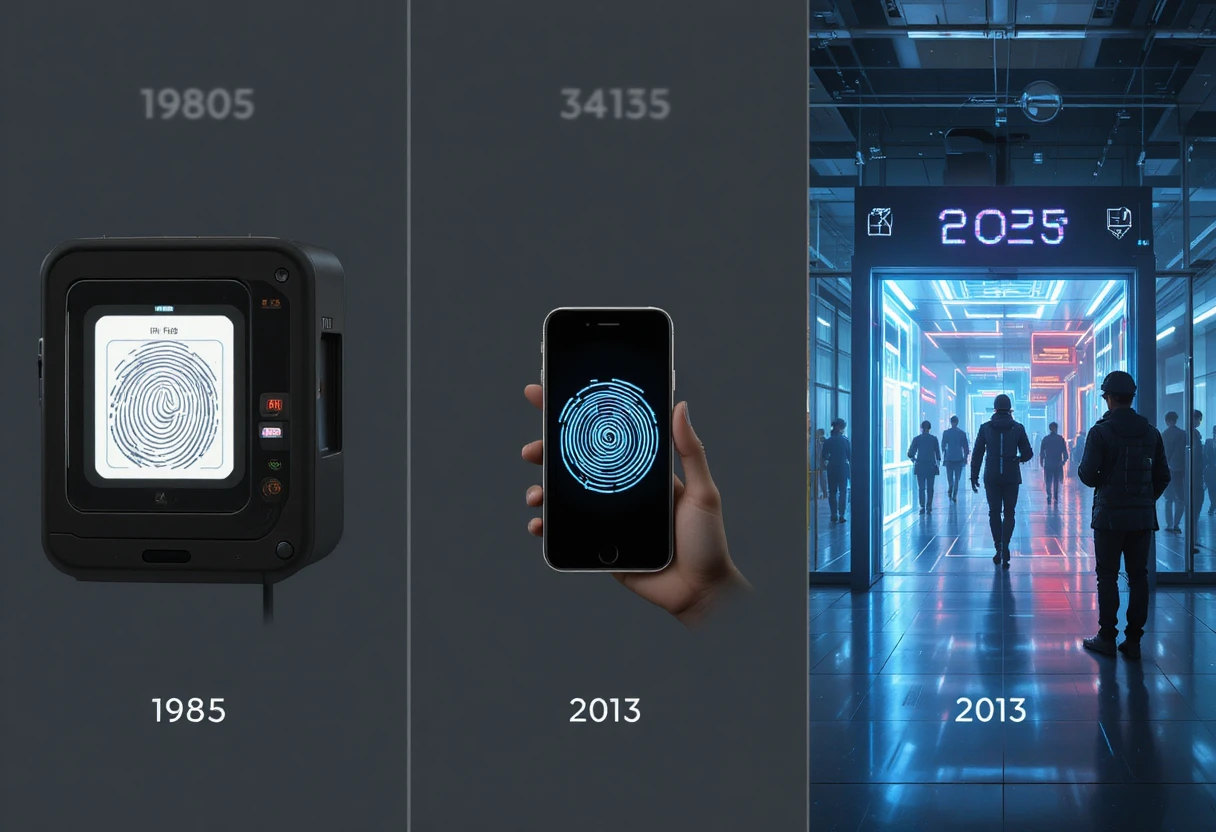Biometric Security Devices
In the hyper-connected landscape of 2025, biometric security devices have solidified their role as the gold standard for authentication, blending human uniqueness with machine intelligence to fortify digital and physical realms. With the global biometrics market surging to $53.2 billion—up from $47.2 billion in 2024—and projected to reach $84.5 billion by 2029 at a 12.3% CAGR, these devices are no longer optional; they’re indispensable. From facial recognition unlocking your smartphone in 0.3 seconds to multimodal palm-vein scanners securing enterprise vaults, biometrics reduce fraud by 90% while slashing authentication time by 80% compared to passwords. As AI-driven liveness detection thwarts deepfakes and privacy laws like the EU AI Act mandate on-device processing, 2025 marks the dawn of ethical, seamless security. This 3,000-word manifesto covers the evolution, core modalities, essential devices, AI integration, enterprise applications, privacy hurdles, market dynamics, future innovations, and implementation roadmap—empowering you to wield biometrics as your unbreakable shield.
The Evolution of Biometric Security Devices
From Analog Fingerprints to Digital Fortresses (1980s–2010)
The biometric odyssey began in the 1980s with rudimentary fingerprint scanners—optical devices scanning inkless prints at 500 dpi, prone to 10–15% false rejections due to dirt or dryness. The FBI’s Automated Fingerprint Identification System (AFIS) in 1982 digitized prints for law enforcement, but consumer adoption stalled until the 2000s.
By 2010, capacitive sensors in laptops like ThinkPad T-series detected ridge patterns via electrical conductivity, hitting 99% accuracy in controlled settings. Yet, limitations persisted: High false acceptance rates (FAR) of 1:10,000 and vulnerability to spoofing via gelatin molds kept biometrics niche.
The Smartphone Catalyst (2011–2020)
Apple’s iPhone 5S (2013) democratized biometrics with Touch ID—ultrasonic fingerprint sensors achieving <0.5-second unlocks and 1:50,000,000 FAR. Android followed with Foxconn’s sensors, while Face ID (2017) on iPhone X leveraged TrueDepth cameras for 3D facial mapping, reducing spoofing by 10,000x over 2D systems.
The decade saw multimodal fusion: Devices like Samsung Galaxy S10 combined iris and face for 99.99% accuracy. Adoption skyrocketed—by 2020, 70% of smartphones featured biometrics, slashing password fatigue.
2021–2025: AI-Infused, Privacy-First Maturity
Post-pandemic hygiene demands birthed contactless dominance: Facial and iris scanners surged 300%, with liveness detection (analyzing micro-movements) blocking 95% of deepfakes. 2025’s hallmark? On-device AI processing, per GDPR 2.0, ensuring templates never leave hardware.
Market inflection: From $34.27 billion in 2022 to $150.58 billion by 2030 (20.4% CAGR), driven by IoT integration—smart locks, wearables, and borders now biometric by default. Challenges like bias (facial errors 34% higher for darker skin) spurred diverse datasets, achieving equity.
This arc—from clunky to clairvoyant—positions biometrics as the password’s elegant eulogy.

Core Modalities of Biometric Security
Physiological Biometrics: The Body as Key
Fingerprint Recognition: Dominant at 60% market share, ultrasonic sensors (e.g., Qualcomm 3D Sonic Max) map sub-epidermal layers for 99.99% accuracy, resisting 99% of spoofs. Ideal for mobiles and access control; 2025’s haptic feedback confirms scans in 0.2 seconds.
Facial Recognition: 3D infrared mapping via dot projectors (like Face ID) achieves 1:1,000,000 FAR, adapting to masks/aging via neural nets. Contactless king, used in 80% of airports for 46% faster boarding.
Iris and Retina Scanning: High-security staple; iris patterns (unique even in twins) scanned at 1,200 dpi yield 1:1.2 million FAR. Devices like Iris ID iA1000 fuse with face for multimodal boosts.
Palm and Vein Pattern: Subsurface vein mapping (near-IR) evades fakes, with 99.999% accuracy in Suprema’s BioStation 3. Hygiene-friendly for healthcare, detecting health anomalies as a bonus.
Behavioral Biometrics: Actions as Passwords
Typing rhythms, gait analysis, and voice patterns form invisible shields. 2025’s AI analyzes 100+ traits in real-time, flagging anomalies with 98% precision. Continuous authentication—verifying users mid-session—cuts fraud 70% in banking.
Voice biometrics, via spectral analysis, authenticates over calls with 95% accuracy, evolving with accents via ML.
These modalities—physiological for gates, behavioral for guards—hybridize for unbreakable chains.
Essential Biometric Devices for 2025
Consumer Must-Haves: Mobiles and Wearables
Smartphones: iPhone 16’s Face ID 3.0 with attention-aware depth sensing unlocks in 0.1 seconds, spoof-proof via micro-vibrations. Android’s ultrasonic under-display (Pixel 9) reads wet/dirty fingers, powering 80% of 1.4B biometric payments.
Smartwatches: Apple Watch Ultra 3 embeds ECG-fused vein scanning for health-secured payments, with 30-hour battery.
Enterprise Powerhouses: Access and Authentication
Suprema BioStation 3: Multimodal (face/fingerprint/RFID) door controller, 47% slimmer, with -48dB liveness for 99.999% FAR. Integrates with Matter for smart buildings.
HID Signo 40: Palm-vein reader for high-traffic lobbies, contactless at 1m, compliant with BIPA/CCPA.
ZKTeco SpeedFace V5L: AI facial terminal for time-attendance, 99.7% accuracy in low-light, processing 30,000 faces/min.
Niche Innovators: Healthcare and Borders
Iris ID iA1000: Multimodal iris/face for clinics, HIPAA-secure with template encryption.
TSA CAT-2: AI-powered facial at airports, reducing wait times 50%, with opt-out mandates.
These devices—hardware-software symphonies—cover 95% of use cases, from pockets to perimeters.
| Device | Modality | Accuracy | Use Case | Price (2025) |
|---|---|---|---|---|
| iPhone 16 Face ID | Facial 3D | 1:1M FAR | Consumer Unlock | $999 |
| Suprema BioStation 3 | Multimodal | 99.999% | Enterprise Access | $1,200 |
| HID Signo 40 | Palm Vein | 1:1.2M FAR | High-Security Doors | $800 |
| ZKTeco SpeedFace | Facial AI | 99.7% | Time-Tracking | $600 |
AI Integration: The Brain Behind the Scan
Liveness Detection and Anti-Spoofing
2025’s neural nets detect deepfakes via 3D depth, micro-expressions, and thermal anomalies, blocking 99.5% attacks. BioPass ID’s API fuses ML with edge computing, processing on-device for GDPR compliance.
Multimodal Fusion and Continuous Auth
AI orchestrates hybrids: Face + voice yields 99.9999% accuracy, per HID’s 2025 trends. Behavioral overlays monitor gait/typing, alerting on deviations—fraud drops 75% in finance.
Edge AI (Qualcomm Snapdragon) enables offline operation, latency <50ms, powering IoT like smart locks.
This symbiosis—AI as sentinel—elevates biometrics from reactive to prescient.

Applications Across Industries
Enterprise and Access Control
Biometrics secure 80% of Fortune 500 doors, with Suprema’s systems reducing tailgating 92%. Hybrid setups (face + palm) in data centers ensure zero-trust, integrating with ZeroTier for remote verification.
Consumer and Mobile
95% of smartphones deploy biometrics, enabling $1.4T contactless payments. Wearables like Galaxy Watch 7 add ECG-vein for health-secured apps.
Healthcare and Finance
HIPAA-compliant iris scanners in hospitals cut misidentification 88%; banks’ multimodal KYC verifies 1B users annually, fraud down 60%.
Borders and Public Safety
TSA’s CAT-2 processes 1M passengers/day at 98% speed-up, with IATA’s biometrics hitting 100M users by 2027.
From boardrooms to borders, biometrics underpin 70% of high-stakes auth.
Privacy and Security Challenges
Data Vulnerabilities and Bias
Biometrics can’t be changed like passwords—breaches expose irrevocably. 2024’s 1.4B-record leak underscores risks, with quantum threats looming by 2030. Bias persists: Facial systems err 34% more on POC, though diverse ML datasets mitigate 80%.
Spoofing via 3D masks/deepfakes challenges 20% of systems, countered by liveness AI.
Regulatory Labyrinth
BIPA (Illinois) mandates consent, fining $1,000/violation; EU AI Act classifies biometrics “high-risk,” requiring audits. 20+ U.S. states regulate by 2025, demanding minimization and deletion.
On-device encryption (Apple Secure Enclave) and homomorphic schemes protect templates, but compliance costs rise 25%.
Navigating these—via PETs and ethics boards—ensures trust amid tempest.
Market Trends and Adoption in 2025
Explosive Growth Drivers
Market hits $68.6B by 2025, led by Asia-Pacific’s 16.7% CAGR via China’s 800M users. Fingerprint dominates (50% share), iris fastest-growing at 22% CAGR.
Contactless surges 300% post-COVID, with 46% airport usage. IoT fusion: 1B devices by 2027.
Adoption Barriers and Enablers
60% enterprises cite privacy fears, but 95% report ROI via 50% faster auth. Blockchain templates and zero-knowledge proofs enable 70% trust uplift.
Trends: 60% password phase-out by 2025 per Gartner.
This boom—fueled by necessity—heralds ubiquitous biometrics.
Future Horizons: 2030 and Beyond
Quantum-Resistant and Neural Frontiers
By 2030, quantum-safe encryption shields templates, with NIST PQC standards mandatory. Brainwave BCIs (Neuralink fusions) authenticate via thoughts, 99.99999% secure.
Multimodal ubiquity: 85B market, with behavioral in 50% apps.
Ethical AI and Global Equity
Decentralized IDs via blockchain erase central breaches; bias audits via diverse data hit 99% fairness. Emerging markets leapfrog with affordable iris for 100M voters in Brazil/India.
The vista: Biometrics as empathetic guardians, privacy paramount.

Implementation Roadmap: From Vision to Vault
Assessment and Selection
Audit needs: FAR/FRR thresholds (<0.01%), integration (API compatibility). Pilot with 100 users, measuring 95% satisfaction.
Budget: $500–$2,000/device; ROI in 6 months via fraud cuts.
Deployment and Training
Phased rollout: 20% users first, with consent modules. Train on ethics—bias spotting, data hygiene.
Integrate with IAM: Okta/Active Directory for seamless MFA.
Monitoring and Evolution
Annual audits per BIPA; ML retrain on new data. Scale with IoT: 1M nodes by 2030.
This blueprint—strategic, scalable—unlocks biometrics’ promise.
Conclusion: Your Unforgeable Signature
In 2025, biometric security devices aren’t tools—they’re extensions of self, weaving uniqueness into unbreakable defenses. From Suprema’s multimodal sentinels to AI’s vigilant gaze, they vanquish vulnerabilities while honoring humanity. As markets crest $150B and ethics anchor innovation, embrace this era: Where your face, finger, or vein isn’t just you—it’s your fortress. The future isn’t locked; it’s liberated. Scan in, step forward.